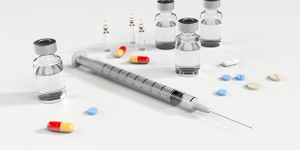A Potential Antibiotic Emerges from Microbial 'Dark Matter'
Infectious bacteria seem to have been gaining the upper hand in recent years, as more and more infections become tough to treat and bacteria gain resistance to more antibiotics. The World Health Organization has warned about the increasing threat posed by these pathogens, and scientists have been looking for ways to reduce the spread of antibiotic resistance, and trying to find new antimicrobial drugs. Creating safe and effective new antibiotics can be a serious challenge. But nature may lend a helping hand in the fight. Penicillin, for example, comes from natural sources. Microbes are also constantly battling each other, which means that they have ways to kill each other. We may be able to exploit those antimicrobial compounds for our own use.
Scientists have now reported the discovery of a new antibiotic, which comes from a bacterium that has not been studied before, and could work against antibiotic resistant superbugs. The novel antibiotic is called Clovibactin, and its mechanism for destroying bacteria has been reported in Cell.
"Clovibactin is different," said Dr. Markus Weingarth, a researcher from the Chemistry Department of Utrecht University. "Since Clovibactin was isolated from bacteria that could not be grown before, pathogenic bacteria have not seen such an antibiotic before and had no time to develop resistance." An interview with Dr. Weingarth can be seen in the video below.
This work was started by US company NovoBiotic Pharmaceuticals and Professor Kim Lewis from Northeastern University, who created a tool for growing bacteria that have been impossible to grow up to this point, or what is sometimes known as "bacterial dark matter."
About 99 percent of bacteria have not been grown in labs, and the culture conditions needed to grow them are unknown. With a device called iCHip, scientists were able to culture a soil microbe found in North Carolina called E. terrae ssp. Carolina.
This microbe generates Clovibactin, which was shown to attack a variety of bacterial pathogens, and was able to eliminate a Staphylococcus aureus superbug in a mouse model. It works by targeting three different molecules that are crucial for the construction of the cell wall of many types of bacteria. This killing mechanism is unlike existing antibiotics.
"The multi-target attack mechanism of Clovibactin blocks bacterial cell wall synthesis simultaneously at different positions. This improves the drug's activity and substantially increases its robustness to resistance development," said Schneider.
Clovibactin only attaches to the immutable pyrophosphate found in many cell wall precursors, while ignoring portions of the target made up of sugars. The researchers suggested this makes it much toughter for microbes to develop resistance to the antibiotic, which they did not observe in their studies.
Clovibactin was also found to self-assemble into fibrils on the surface of bacteria after binding its targets. Because the fibrils are stable, they can ensure that the targets stay in place so bacteria can be killed. These fibrils are also not found on human cells, so the antibiotic may be totally safe for us. More work will be needed before it can be used in people, but Clovibactin has huge potential to help destroy problematic bacteria.
Sources: Utrecht University, Cell









